
A brief history of the Toronto Transit Commission
The TTC and its neverending tour of the city will turn 92 this weekend. Loved, loathed, lauded, and pilloried for close to a century (sometimes at the same time,) the TTC is a defining feature of the city and one of its most recognizable institutions.
What started out as a way to consolidate the city's multiple public and private transit systems in to a single network evolved, sometimes turbulently, over almost a century in to the owner and manager of the one of the largest streetcar networks on the continent with an annual operating budget of $411 million.
This is the story of how Toronto took "the better way" from horse and carriage to the Rocket subway.
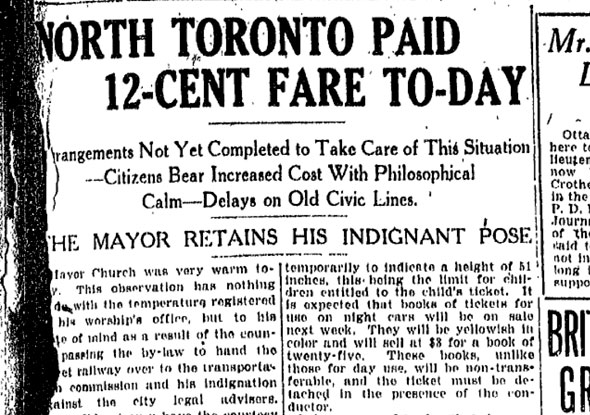
The Toronto Transportation Commission was established on September 1, 1921 with the merger of two street railway companies: the privately owned and operated Toronto Railway Company, which typically ran downtown, and the city-owned Toronto Civic Railways, which was created to serve newly annexed neighbourhoods the TRC wasn't interested in serving.
Prior to the forming of the TTC, a handful of rival transit companies vied for space on Toronto's streets, starting in 1849 with the Williams Omnibus Line. The early system, named for H. B. Williams, a cabinet maker and undertaker who built his own horse-drawn vehicles, linked the St. Lawrence Market with the Red Lion Inn on the northeast corner of Bloor and Yonge.
At its zenith, Williams had four six-passenger and two larger stagecoaches that charged hardy passengers sixpence for rattling journeys along unpaved and rutted roads.
Later that century, a handful of other companies, several of which were linked to electricity interests, operated street railways or bus lines in Toronto with radial services to outlying towns like Guelph, Aurora, Newmarket, Richmond Hill, and Sutton West.
Passengers transferring between these various rival companies often had to pay multiple fares, a key issue during the formation of the TTC. Mayor Thomas Church promised when the Commission was founded on September 1, 1921 that the entire city would fall under a single fare system.
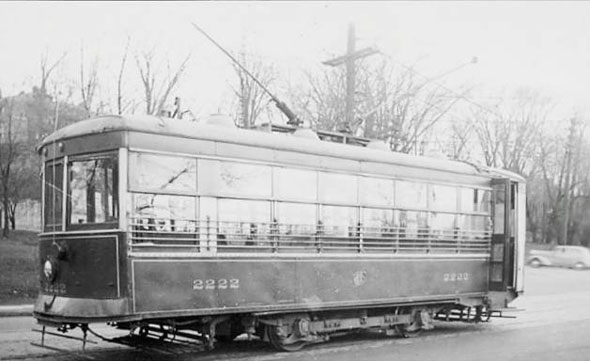
The workhorse of the early TTC streetcar lines was a fleet of 25 simple wooden Preston Car Company vehicles (not to be confused with the later Presidents' Conference Committee cars that share the same initials) inherited from Toronto Civic Railways.
The Birney fleet, as they were known, had controls at both ends, basic wooden bench seats, and a wood-burning stove located near the front for use on frigid winter days. Just nine metres long and with room for just 52 people, the fleet were the smallest cars ever operated by the TTC
The tracks beneath the rattling Birney cars were, and still are, something of an oddity. All TTC rails with the exception of the Scarborough RT are spaced a non-standard 4 feet 10 7/8 inches apart, slightly wider than the commonly-used international standard (there are still many railways that don't used standard gauge, though.)
A long-standing urban myth attributes the odd TTC gauge to concerns rail companies like Canadian Pacific would try to run trains down Toronto streets. Not so, says TTC authority Transit Toronto. The rail spacing was actually meant to allow non-Toronto Street Railway vehicles - horse and wagons - to use the tracks too, providing it didn't interfere with transit operations.
The spacing was repeated with each new generation of streetcar for convenience and eventually on the subway. At one time old streetcars were converted for use as work cars on the subway, a process made easier by the matching track guages.
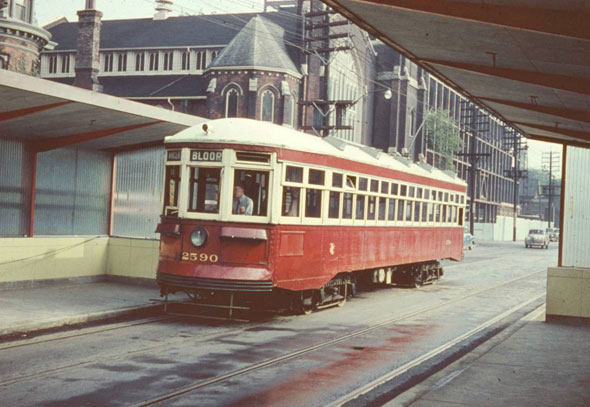
The first fleet of streetcars purchased by the Toronto Transportation Commission were the maroon and gold Peter Witt cars. Built in various sizes by three different manufacturers between 1921 and 1923, the design, austere with wooden benches and a simple heater, was based on one used by the Cleveland Street Railway in the United States (the eponymous Peter Witt was a commissioner of the Cleveland network.)
The Witts came in several sizes and forms and were regularly used on the Yonge and Bay lines until the introduction of the fist Presidents' Conference Committee cars in 1952 and the opening of Canada's first subway line.
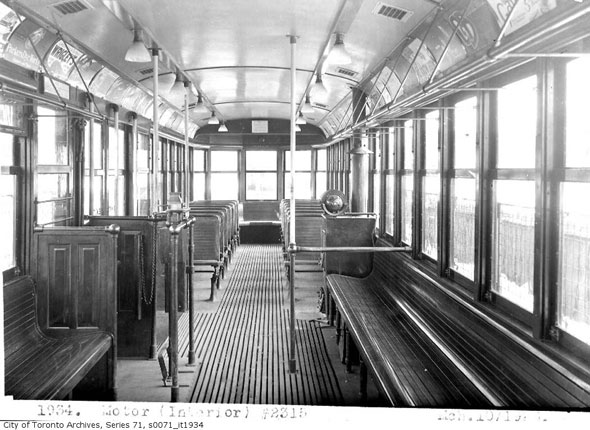
The original Yonge line between Union and Eglinton opened in 1954 and very nearly heralded the end of streetcars in Toronto. The TTC believed, like many North American cities, in abandoning surface rail in favour of underground rapid transit or bus lines. Montreal, Ottawa, Halifax, Hamilton, Vancouver, and Edmonton were all actively engaged in ripping out their lines (or had already finished doing so) by time the $447.2 million, 7.4 km subway line opened in 1954.
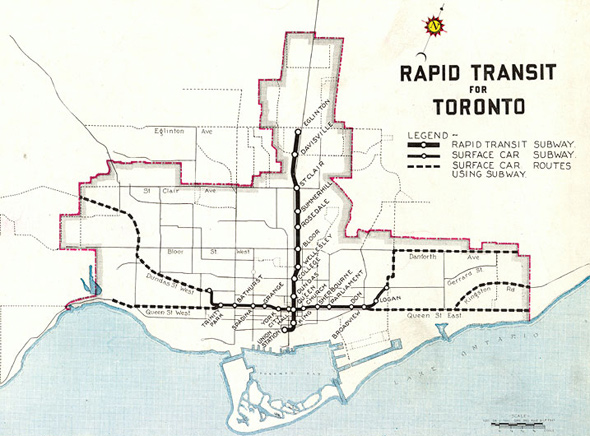
Toronto's Streetcar Abandonment Policy began to bite shortly after. Sherbourne, Dovercourt, Lansdowne, Spadina, Yonge, and Weston all lost their tracks in favour of buses after 1940. Rogers Road and Mount Pleasant would encounter a similar fate in the decades after.
The city was supposed to be entirely streetcar free by the 1980s, when the latest incarnation of the long lost Queen subway - at times an underground streetcar line like the one on Queen's Quay, later a rapid transit line - was tentatively scheduled to open. Luckily, a citizen-led group, Streetcars for Toronto, was able to stem the tide and halt, if not reverse, much of the abandonment plans.
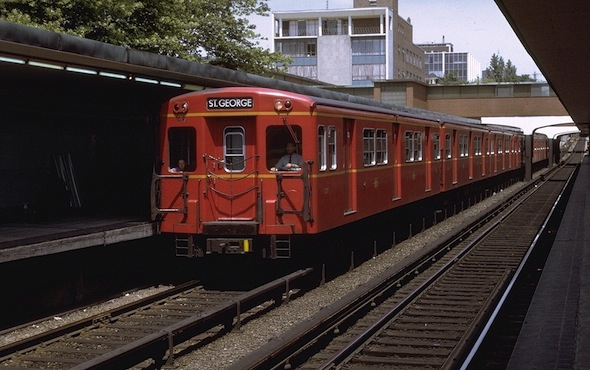
The Yonge line, the first subway in the country, was the pride of the TTC and post-war Canada when its red Gloucester cars first took to the rails. More than 434,000 tons of steel and cement, 35,397 cubic metres of timber (mainly for the wooden cover built over the construction trench,) 410,000 tons of sand and gravel went in to the line.
The University line (Union to St. George) and the Bloor-Danforth line (Keele to Woodbine) opened in the mid-60s, rounding out Toronto's 20-year subway boom. For a short time the entire subway was knitted in together in three routes, making it possible to ride downtown without changing from the Bloor-Danforth line. The now-closed second platform beneath Bay station is the best-known relic of this brief "interlining" period.
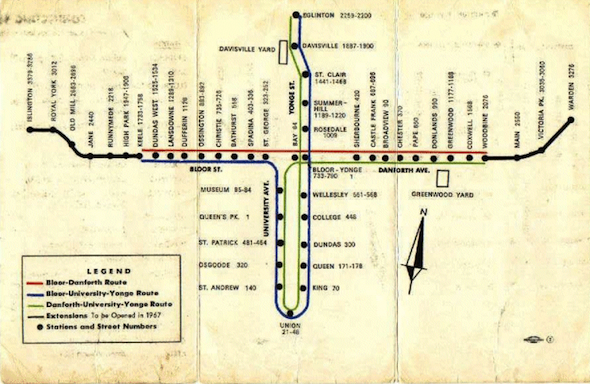
Another interesting fact about the Bloor-Danforth line concerns the Prince Edward Viaduct. When it was built in 1918, the designs included several useful provisions for a railway beneath the road deck. The designer, Edmund W. Burke, couldn't have imagined what form the subway would ultimately take, but it's a good thing he tried.
When the line arrived 42 years later engineers were able to use existing supports and passages through the support towers with only minor modifications and upgrades. The curve from Castle Frank to Sherbourne station proved too tight for similar foresighted structure on the Rosedale Ravine section to be useful so a separate, covered bridge was built slightly to the north.
The subway trains from the 1960s and 1970s included the short-lived Montreal Locomotive Works "M1" cars - the first rapid transit vehicles to be designed and built in Canada - and the Hawker Siddeley H1, H2, H3, H4, and H5 cars, the last of which survived until a few months ago.
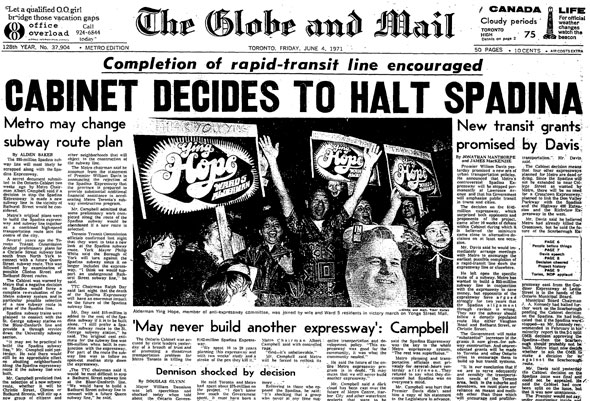
That decade also produced perhaps the finest hour for transit advocacy in Toronto in the form of the proposed (and partially built) Spadina Expressway. As originally conceived, the multi-lane highway would have sliced through the Cedarvale and Nordheimer Ravines, down Spadina Avenue to the Gardiner, carving up The Annex, Kensington, and other neighbourhoods.
The road got the chop after years of effort from activists and high-profile campaigners like urban theorist Jane Jacobs and Marshall McLuhan. "Toronto will commit suicide if it plunges the Spadina Expressway into its heart," McLuhan protested. The Spadina subway north of Bloor survived the axe, however, running in the median of the renamed Allen Road north of Eglinton Avenue as originally planned.
Toronto's streetcar system began to recover from the deliberate decay in the late 1970s with the arrival of the first CLRV vehicles. The first five in the current streetcar fleet were built in Switzerland and shipped to Canada in 1979. As archival photos show, the original seating layout was somewhat different and the car interiors and once bore a striking resemblance to the familiar layout used on the subway.
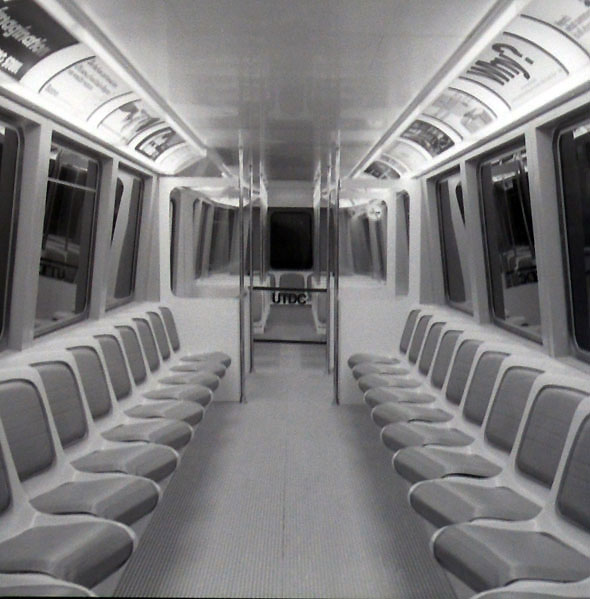
Although the TTC choses not to, the cars are capable of being tethered together in a train. While it was shopping the CLRV design to Boston, the Urban Transportation Development Corporation (UTDC) coupled six together in a successful test at the St. Clair Carhouse in 1982.
The streetcars were tested in series several other times, too. The large empty cavity below the rear seats is the most obvious evidence of the lost feature. The connecting gear would have filled that space.
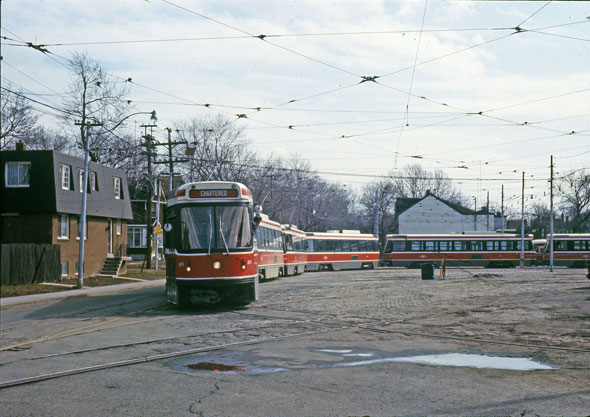
The purchase of the CLRV and its double-length, articulated relation the ALRV heralded a revival of surface transit in Toronto. The sleek new cars were briefly considered for the Scarborough RT but later ditched in favour of the high-tech ICTS vehicles being pushed by the UTDC, a crown corporation mandated to build rapid transit vehicles.
So far, despite the odd derailment, no CLRV or ALRV has been retired, destroyed, or written off in the line of duty. It's entirely possible that when the new streetcars arrive next year the entire fleet will have gone the distance with only a few bumps and scrapes.
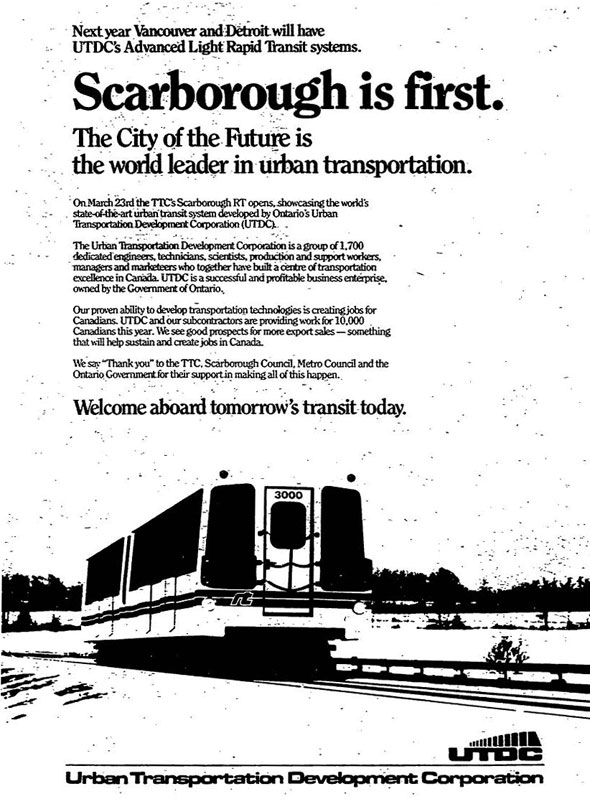
The pride of the 1980s, the Scarborough RT, opened in a disused hydro corridor and elevated right-of-way in 1985 and was for a time the most technologically-advanced rapid transit system in the world with its driverless control system and linear induction motors, which are related to modern mag-lev and roller coaster technology.
Perhaps the most memorable gift from the RT (apart from its ground-breaking design) is the three-tone door chime used on the subway. Before that, subway journeys began with "two piercing whistle blasts," according to the Toronto Sun.
The most recent attempt to build a new subway, save for the Sheppard line and the current wrangling over converting the Scarborough RT, took place in the 1990s with the a line that would have run four stops west under Eglinton Avenue from Eglinton West station. A political hot potato (as these things always are,) the line was killed less than a year after construction on the first phase had begun at the southern terminus of Allen Road.
The half-finished excavation pit with its $50 million pricetag was filled in in 1995 and the project added to the long, dark list of Toronto transit nightmares.
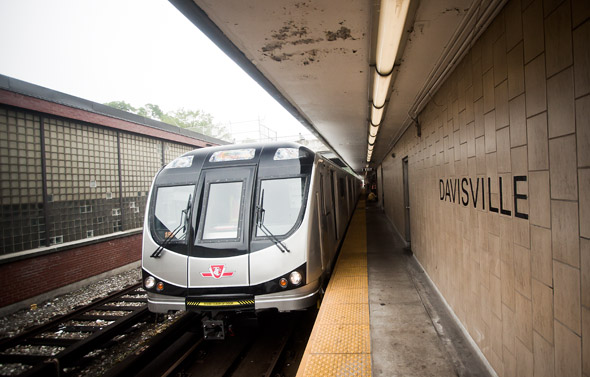
Later that year, the Russell Hill subway disaster - attributed to a signal fault and an error by an inexperienced driver - killed three people and hospitalized 30. On August 11 at 6:03 PM a southbound train that had just left St. Clair West station rear-ended a stationary train just north of Dupont.
It was the worst subway accident in Canadian history and led to a total overhaul of training procedures and signal technology. Other incidents in the subway's past had never claimed a life. Fires at Union, Christie, and Old Mill stations left scars, some of which are still visible in miscoloured tiling, but didn't elicit the same level of response.
Every year the TTC receives a Due Diligence Checklist which details how the Commission is putting in to practice the 18 recommendations outlined in the coroner's report published in the aftermath of the crash.
The final Hawker H-5 subway train with its yellow and faux-wood interior trim retired a little awkwardly in June this year. The remaining H-6 trains (think orange interior panels and doors) are currently circulating on the Bloor-Danforth line only.
The Bombardier T1 (red doors, fewer seats) and brand new Toronto Rocket trains are the most recent cars rumbling under the city's streets. The latter, the first to feature an open concept design, among a host of other accessibility and comfort improvements, arrived in May 2011.
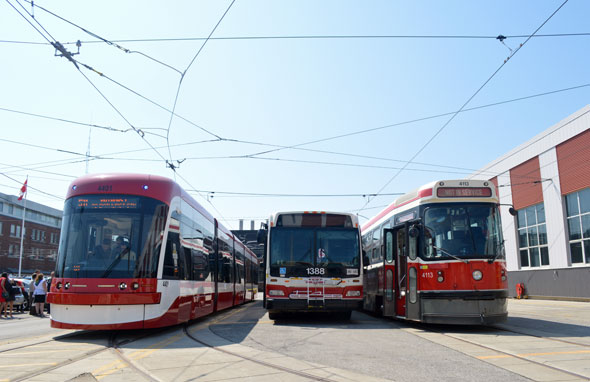
Toronto's transit network reached its current state - three subway lines, 69 stations, one above ground RT, 304.6 kms of streetcar lines, 170 bus routes - with the completion of the Sheppard line in 2002.
The 5-stop purple line is a stub compared to what was originally proposed. Had the money been available (we've heard that before,) the line would have run from Downsview to Scarborough Centre by way of its current truncated route under Sheppard Avenue.
Mel Lastman championed the line that was supposed to spur development on one of north Toronto's busiest corridors. A survivor of the transit plan that died with the Eglinton subway, Sheppard has never managed to quite shake its reputation for being a subway to nowhere, despite having some success.
"Sheppard's technology makes it both expensive to abandon and expensive to extend; that's the trap," Jarrett Walker, a transportation consultant told the Globe and Mail.
Next year Toronto will get its hands on the first of the $1.2 billion fleet of new streetcars, which will operate on Dundas, Spadina, Bathurst, and Harbourfront lines. Another new chapter in almost 100 years of history.
Chris Bateman is a staff writer at blogTO. Follow him on Twitter at @chrisbateman.
Images: Chris Bateman, Derek Flack, Ray Corley, Toronto Star Archives, Globe and Mail Archives, City of Toronto Archives, Wikimedia Commons.
Latest Videos
Latest Videos
Join the conversation Load comments







